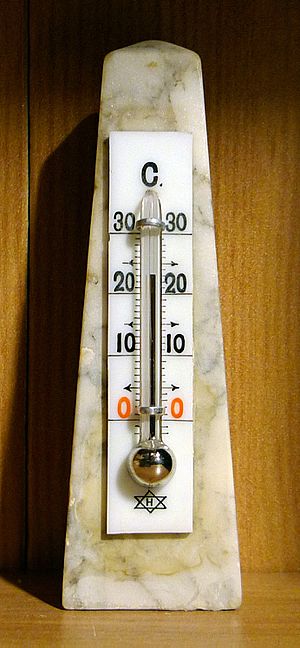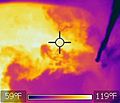Liquid facts for kids
A liquid is a form of matter. It is settled between solid and gas. Liquid has an almost-fixed volume, but no set shape.
Every small force makes a liquid change its shape by flowing. Because of that, gravity makes liquids always take the shape of the container. The molecules that make up the liquid can freely move among themselves.
Fluids that flow slowly have a high viscosity. Some fluids like tar have such a high viscosity that they may seem solid.
It is difficult to compress a liquid. If a liquid is cooled down until it is colder than a certain temperature, it will become a solid. This temperature is called the melting point and is different for every different type of liquid. The freezing point of water is around 0°C, and it becomes ice. If a liquid is heated up it becomes a gas. The temperature this happens at is called the boiling point. The boiling point of water is 100°C, at this temperature it becomes steam.
Examples of liquid are water, oils and blood.
In a liquid, the liquid on the top presses down on the liquid underneath, so at the bottom the pressure, p, is bigger than at the top. The equation for working this out is:
- p = ρgz
where z is the depth of the point below the surface and g is how strong gravity is pulling on the liquid. ρ is a number that tells us how heavy a set amount of the liquid is. We call this the density and it is different for all liquids.
Applications

Liquids have a variety of uses, as lubricants, solvents, and coolants. In hydraulic systems, liquid is used to transmit power.
In tribology, liquids are studied for their properties as lubricants. Lubricants such as oil are chosen for viscosity and flow characteristics that are suitable throughout the operating temperature range of the component. Oils are often used in engines, gear boxes, metalworking, and hydraulic systems for their good lubrication properties.
Many liquids are used as solvents, to dissolve other liquids or solids. Solutions are found in a wide variety of applications, including paints, sealants, and adhesives. Naphtha and acetone are used frequently in industry to clean oil, grease, and tar from parts and machinery. Body fluids are water based solutions.
Surfactants are commonly found in soaps and detergents. Solvents like alcohol are often used as antimicrobials. They are found in cosmetics, inks, and liquid dye lasers. They are used in the food industry, in processes such as the extraction of vegetable oil.
Liquids tend to have better thermal conductivity than gases, and the ability to flow makes a liquid suitable for removing excess heat from mechanical components. The heat can be removed by channeling the liquid through a heat exchanger, such as a radiator, or the heat can be removed with the liquid during evaporation. Water or glycol coolants are used to keep engines from overheating. The coolants used in nuclear reactors include water or liquid metals, such as sodium or bismuth. Liquid propellant films are used to cool the thrust chambers of rockets. In machining, water and oils are used to remove the excess heat generated, which can quickly ruin both the work piece and the tooling. During perspiration, sweat removes heat from the human body by evaporating. In the heating, ventilation, and air-conditioning industry (HVAC), liquids such as water are used to transfer heat from one area to another.
Liquid is the primary component of hydraulic systems, which take advantage of Pascal's law to provide fluid power. Devices such as pumps and waterwheels have been used to change liquid motion into mechanical work since ancient times. Oils are forced through hydraulic pumps, which transmit this force to hydraulic cylinders. Hydraulics can be found in many applications, such as automotive brakes and transmissions, heavy equipment, and airplane control systems. Various hydraulic presses are used extensively in repair and manufacturing, for lifting, pressing, clamping and forming.
Liquids are sometimes used in measuring devices. A thermometer often uses the thermal expansion of liquids, such as mercury, combined with their ability to flow to indicate temperature. A manometer uses the weight of the liquid to indicate air pressure.
Images for kids
-
The formation of a spherical droplet of liquid water minimizes the surface area, which is the natural result of surface tension in liquids.
-
A lava lamp contains two immiscible liquids (a molten wax and a watery solution) which add movement due to convection. In addition to the top surface, surfaces also form between the liquids, requiring a tension breaker to recombine the wax droplets at the bottom.
-
Surface waves in water
-
A simulation of viscosity. The fluid on the left has a lower viscosity and Newtonian behavior while the liquid on the right has higher viscosity and non-Newtonian behavior.
See also
 In Spanish: Líquido para niños
In Spanish: Líquido para niños







